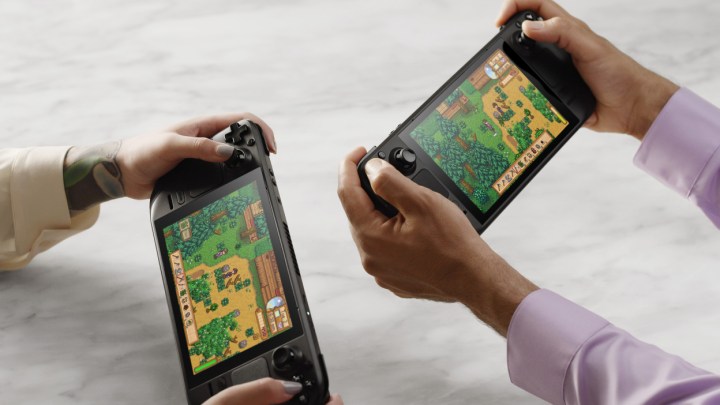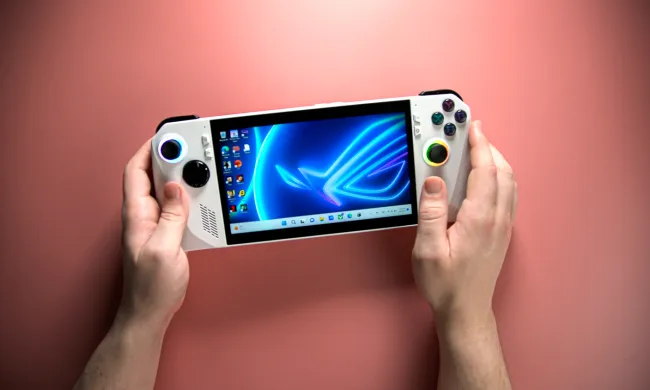The reviews for the Steam Deck are out, and in general, they’re quite positive. Reviewers have praised how fun it is to play big PC games on a small screen, and gushed over the quality of the thumbsticks. Even more minor aspects like the speakers got a near-universal thumbs-up.
But that doesn’t mean the Steam Deck scored perfectly. We rounded up all of the biggest issues reviewers have had with the device so far, ranging from the hardware itself to the current state of the software.
It’s big and heavy

We’ve known the Steam Deck was bigger than your average handheld for quite some time. It weighs a pound and a half and is nearly two inches thick — significantly chunkier than a Nintendo Switch. But the review over at Engadget really highlighted how the bulk affects the overall experience of carrying and playing on the Steam Deck.
Reviewer Jess Conduit says the following: “I find myself holding the system low in my lap, often propping it up on my thighs and craning my neck down in order to play. After about an hour in this position, the muscles along the back of my head start to ache, and I’ve been calling this phenomenon Steam Deck neck.”
The portability of the Steam Deck is one of its most important features, so how it feels to actually hold the device for long periods of time is critical. That being said, the Steam Deck doesn’t feel like a system you’re meant to play for hours and hours on end in one sitting, so this could be something a reviewer might observe more strongly than the average person.
Battery life

The battery life seems to be the larger hurdle for long playing sessions with the Steam Deck. The device has a 40 watt-hour battery, which Valve says can deliver anywhere between two and eight hours of gameplay on a single charge. For some reviewers, that doesn’t seem to have been quite enough.
Andrew E. Freedman over at Tom’s Hardware says the following about the battery life: “When I played Guardians of the Galaxy on low settings with display brightness at 50%, Wi-Fi on and Bluetooth off, I played for 2 hours and 6 minutes until I got a warning that the battery fell under 10% and the Deck needed to be charged.”
Freedman makes note that the intensity of the game you’re playing will have a significant effect on battery life. None of this is a surprise, especially when you think about gaming on battery on a laptop. It’s generally discouraged, and you can’t expect more than an hour or two if you do. The Steam Deck has different hardware than a standard gaming laptop, but for a device that will primarily be played away from an outlet, this could be a problem for people.
Then again, it’s not an issue the Nintendo Switch is free from, yet that hasn’t held back the success of that handheld.
Buggy software

A number of reviews commented on the current state of the software experience, with some finding the experience more than just a minor annoyance. Sean Hollister over at The Verge described it with some fairly harsh words: “It’s rushed, unfinished, buggy, and unstable. If Valve sold the console I’ve been playing at Best Buy or GameStop, people would return it in droves.”
The problems he uses as examples range from the Chrome browser refusing to open in SteamOS to issues with trying to install other applications.
Of course, as Hollister explains, Valve isn’t and probably never will sell the Steam Deck to reach that kind of mainstream audience. As a pioneer of the Early Access business model, Valve clearly is taking the same approach with the Steam Deck.
Hopefully, like many of the games in its library, it’s something Valve can make some quick progress on before the Steam Deck gets into more hands.
Windows isn’t ready

The Steam Deck launches with support for lots of games, but that doesn’t mean all your PC games will work. In fact, in order to run non-Steam games, you’ll need to reboot and install Windows (since the Steam Deck runs on Linux). Unfortunately, as nearly all reviewers pointed out, the promised Windows graphics driver wasn’t ready to go on day one.
This hopefully won’t be a problem in the long run, but it should be noted for early adopters that one of the most anticipated features of the Steam Deck may take a while to iron out.
The docking station and app shortcuts also weren’t available on launch day, meaning some of the features and experiences the Steam Deck promised simply aren’t available right now.


